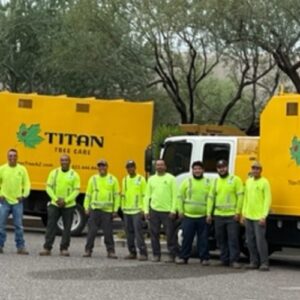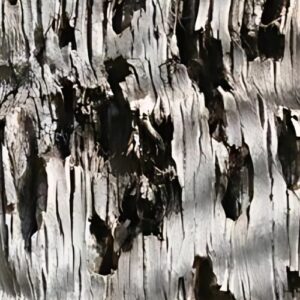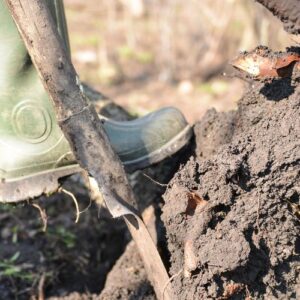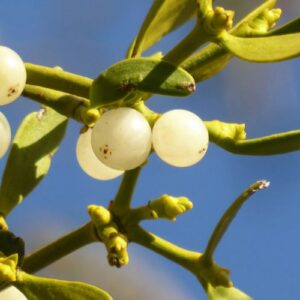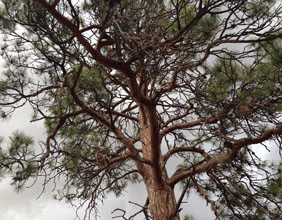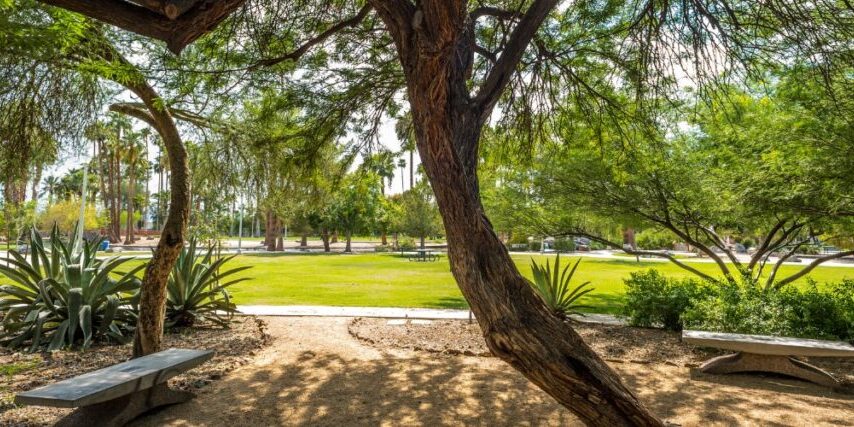
Mesquite trees don’t just survive in the desert – they thrive, bursting to life each spring with honey-scented blooms that add a pop of much-needed color to Arizona’s otherwise muted landscape. Hardy and iconic, they’re as much a part of the Southwest as saguaros and sunrises.
While their feathery leaves and twisted trunks may charm some homeowners, others quickly learn that these trees come with some unexpected challenges. Here’s what you should know before planting one, so you can decide if a mesquite tree makes sense for your property.
Key Takeaways:
- Mesquite trees offer drought tolerance and natural shade, but their roots and size can overwhelm small residential yards.
- Many mesquites have long thorns and drop messy seed pods, though some hybrid varieties reduce those issues.
- Their deep roots make them incredibly resilient – but also hard to remove and risky near underground infrastructure.
- Mesquite trees thrive in their native desert environment, but the same traits that make them ideal here can cause serious problems in other parts of the world.
- Choosing the right mesquite tree – or deciding whether to plant one at all – comes down to your yard size, goals, and maintenance tolerance.
Common Types of Mesquite Trees in Arizona
While there are over 40 species of mesquite trees found worldwide, there are only a few types that usually grow in Arizona, and specifically the Phoenix and Anthem areas:
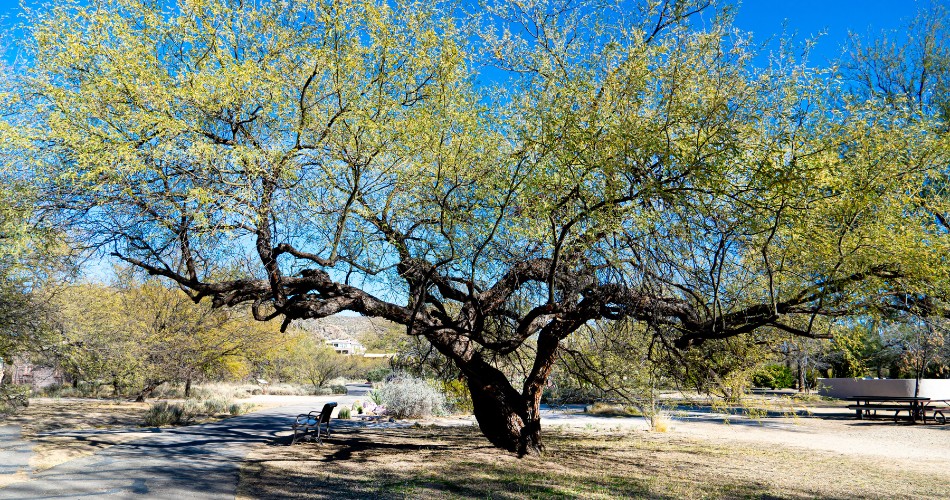
Velvet Mesquite (Prosopis velutina)
Also Known As: Native mesquite or Arizona Mesquite
Height: 30-50 feet
Spread: 30-50 feet
Growth rate: Slow to moderate (moderate to rapid with abundant water)
Where it grows: Southern Arizona
Bark: Dark brown, rough, shaggy
Shade: Casts light, filtered shade, making it an ideal nurse tree
Leaves: Gray-green with 12-30 small leaflets on one or two pairs of pinnae
Flowers: Cream-colored or pale yellow, 2-3 inches long
Thorns: Small thorns (up to one inch long), becoming less thorny as the tree matures because the yellow spines typically only grown on young branches
Velvet mesquites are so named because of the tiny hairs that cover young trees. They are the most common type of mesquite tree found throughout Arizona. Often multi-trunked, they are found growing in dry grasslands or near streams.
The wood from velvet mesquites is used for furniture and can be popular because of its unique grain. If well cared-for, velvet mesquites can live for several hundred years.
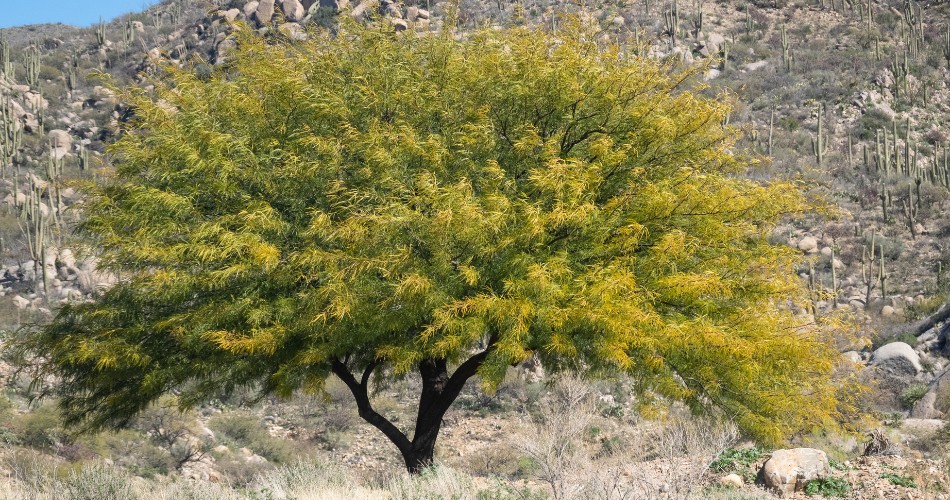
Texas Honey Mesquite (Prosopis glandulosa)
Height: 15-40 feet
Spread: 15-40 feet
Growth rate: Medium to fast growing, especially when watered
Where it grows: Southwestern U.S. and northern Mexico
Bark: Tan and smooth when young, becoming more rough and dark over time
Shade: Creates dappled shade
Leaves: 6-24 leaflets on 1-2 pairs of pinnae
Flowers: White or pale yellow in spring and summer
Thorns: Reddish thorns, although some thornless cultivars are available
Texas honey mesquites are recognized by their longer, drooping branches, often growing in a weeping form. In their natural habitat, the trunk often grows crooked. The tree itself grows
into a rounded canopy of fern-like leaves. The Texas honey mesquite tree gets its name because it is a popular pollen source for bees and other pollinators.
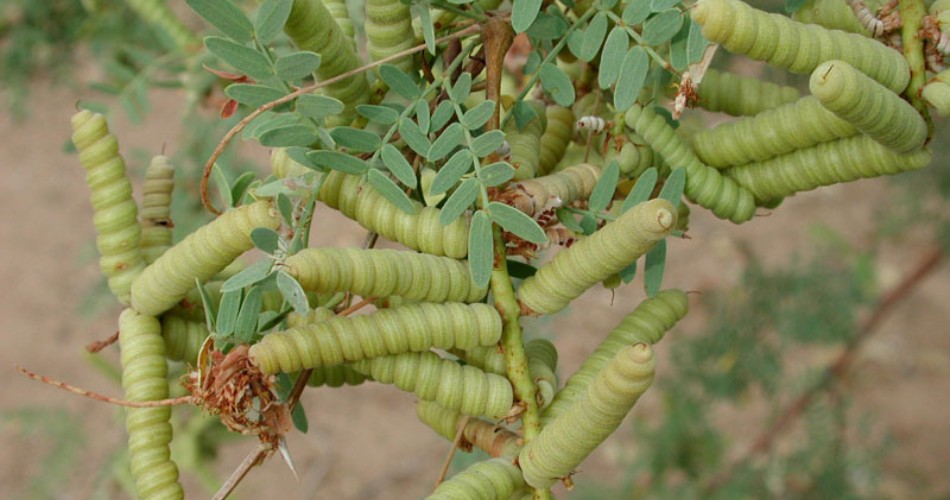
Screwbean mesquite image courtesy of Pompilid – Own work, CC BY-SA 3.0
Screwbean Mesquite (Prosopis pubescens)
Also Known As: Tornillo mesquite
Height: 25 feet
Spread: 25 feet
Growth rate: Very slowly without irrigation
Where it grows: Sonoran desert, Chihuahuan desert, Arizona, Texas, New Mexico
Bark: Shaggy and flaky on older trees, can sometimes peel
Shade: Filtered
Leaves: Smaller than other mesquites, one pair of pinnae with 5-9 pairs of leaflets
Flowers: Bright yellow or white, 3 inch-long, conical blossoms
Thorns: ¾ to 1 inch-long white thorns appear in pairs on branches
The screwbean mesquite is named after the seedpods, which can look like a spring or screw. The alternate name, “Tornillo,” means screw in Spanish. It often has multiple stems and has a spreading crown that is shaped like a vase.
Hybrid Mesquites
In areas where varieties of mesquite trees overlap, there are some natural hybrids.
Chilean and Argentine mesquites are sometimes introduced in Southern Arizona, but they tend not to do well in our winters. Still, you might see some black mesquites (Prosopsis nigra), Argentine mesquites (Prosopsis alba), and Chilean mesquites (Prosopsis chilensis) growing or sold at nurseries. The Chilean mesquite, in particular, is popular because of its smaller thorns and filtered shade.
The Positives and Negatives of Mesquite Trees
Mesquite trees are a staple of the desert – tough, drought-tolerant, and full of character. But just because they belong here doesn’t mean they belong in every yard. From roots that reach farther than most people expect to thorns, seed pods, and invasive tendencies in the wrong setting, there’s a lot to consider.
Here are the pros and cons so you can decide if a mesquite tree is the right fit for your property – or a future headache you’d rather avoid.
Roots
Mesquites have two kinds of roots:
- Lateral Roots: These roots are incredibly long, often extending far beyond the tree’s canopy.
- Deep Taproots: Taproots can grow deep into the soil, sometimes as far as 150 to 200 feet!
Thanks to this combination root system, mesquites are extremely drought tolerant. (Note: Even drought tolerant trees can benefit from a long and deep watering during drought conditions).
A mesquite tree’s far-reaching roots can also be a cause for concern. It can be difficult or nearly impossible to grow anything else under a mesquite tree (or within several feet of it) as the mesquite tends to soak up all the available moisture. While tree roots can’t break into intact pipes, they will find their way in if there is even a tiny crack, leading to costly plumbing repairs.
Thorns
Mesquite trees have thorns that grow up to 3 inches long. These thorns can be painful to step on and a nuisance if the branches are near a walkway. Some people have an allergic reaction to the thorns of mesquite trees, so use gardening gloves if you are handling any mesquite branches.
These thorns can work to your advantage, however, if you need some sort of protective screen. When mesquite trees are grown as short shrubs, several of them grown close together can provide not only privacy but a nearly impenetrable security barrier.
If you like mesquites but the thorns are the only thing deterring you from getting one, there are some thornless hybrids available.
Nitrogen
Mesquites are part of the legume family (think peas and peanuts), and as such, are unique in that they work with specific kinds of bacteria to add nitrogen to the soil. What this means is that they essentially fertilize themselves and any neighboring plants.
Nitrogen-rich soil is not always wanted or needed, however, so knowing the composition of your property’s soil and what it needs is an important first step before planting anything.
Seed Pods
Mesquite seed pods have long been a local food source for livestock, wildlife, and even people. You can harvest them yourself and grind them into a slightly sweet flour that’s low-glycemic and safe for people with diabetes. During the Civil War, mesquite pods were even used as a coffee substitute.
Keep in mind, mesquite trees produce an abundance of seed pods, so be prepared for the “litter” of seeds every year. The seeds have been shown to be viable for up to 50 years, which is one of the reasons that mesquite trees are able to survive in many areas.
Depending on the weather conditions each year, a mesquite tree may produce fewer seed pods due to frost damage to the flowers, drought, or other environmental factors.
There are some hybrids that are “seedless” if you want to avoid the mess from the seed pods, but keep in mind that those trees provide fewer benefits for wildlife. Because mesquite trees can easily cross-pollinate, no tree is guaranteed to be completely seedless (or thornless).
Size at Maturity
The size of a mesquite tree depends on the species, the location and elevation where it is planted, and how much water it receives.
In higher elevations, mesquites grow shorter and more like shrubs. Similarly, if a mesquite doesn’t receive a lot of water, it is more likely to remain short and shrubby. Throughout Phoenix and Anthem, mesquite trees can grow to their full expected height, providing either dappled or full shade to the surrounding area.
However, in smaller residential yards, mesquite trees can quickly outgrow their space – both in height and with their wide-reaching roots.
Always keep in mind the full-grown size of any tree before you plant it on your property.
Drought Tolerance
Mesquites are masters of survival. Their root systems allow them to go dormant in tough conditions, dropping leaves and slowing growth to conserve water. This is a big reason they thrive in Arizona.
Because they’re so good at surviving harsh conditions, mesquite trees have become invasive in many parts of the world. Their deep roots and drought tolerance make them hard to kill and even harder to remove – especially once they start spreading. Their roots compete with crops for water, and their seeds – often viable for decades – make control and eradication a long-term challenge.
In places like Africa, Asia, and Australia, they’ve earned nicknames like “trash tree” and “devil tree” for how aggressively they take over.
Isn’t it ironic that the same traits that make mesquite trees ideal for the Phoenix and Anthem area are exactly what make them a problem in other parts of the world?
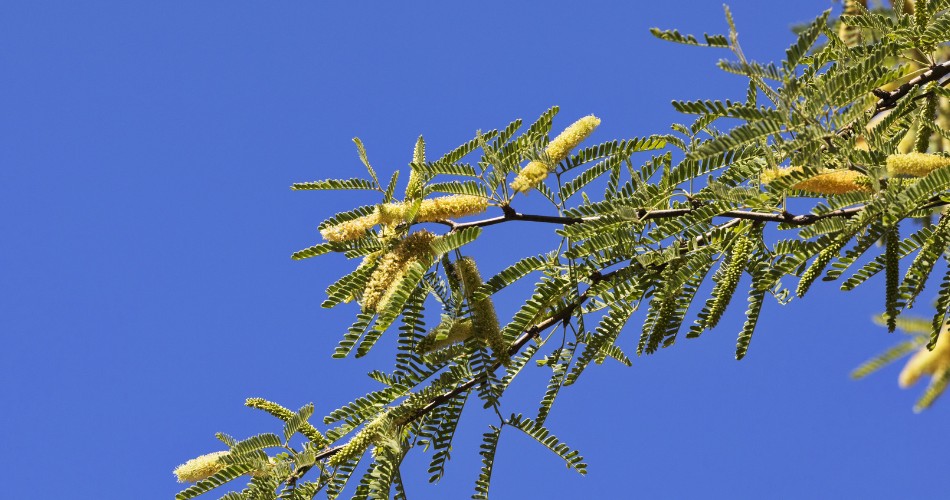
Flowers (Catkins)
Mesquites produce long, pale-yellow flower spikes (called catkins) in late spring, signaling the start of warm-season gardening. These flowers are rich in nectar and attract pollinators, especially bees. In fact, mesquite honey is a local delicacy often produced by beekeepers who place hives near blooming trees.
Similar to the seed pods, these catkins can create a bit of a mess. As they drop, they tend to collect on patios, in pools, or along walkways, requiring cleanup if the tree is planted close to high-traffic areas.
While they’re great for pollinators, their short bloom period means a lot of debris in a short amount of time – something to keep in mind when deciding where to plant.
FAQs About Mesquite Trees in Northern Phoenix
Are mesquites a tree or a shrub?
You may be surprised to learn that mesquites are the most common tree/shrub in the desert southwest. In shallow soil, mesquites may grow to only 3 feet tall, making them a shrub. But if the soil is deep and there is enough irrigation, mesquite trees can grow 30 to 50 feet tall!
How messy are mesquite trees?
Mesquite trees can drop a lot of seed pods, leaves, and twigs – especially in summer. While they’re great for shade, they do require regular cleanup if planted near patios, pools, or walkways.
Do all mesquite trees have thorns?
Many native mesquites do have thorns, but some hybrid varieties (like Chilean mesquite) are thornless. Just keep in mind that even thornless types can grow thorns due to cross-pollination.
Is planting a mesquite tree on your property a good idea?
We love our native mesquite trees and enjoy seeing them in our community. However, not all trees suit all yards. If you don’t have a large property, are worried about invasive roots, or think that the thorns or seed pods would pose a problem, then a mesquite tree probably isn’t for you.
What’s the best mesquite tree to plant in my yard?
That depends on what you’re looking for. If your priority is a native, wildlife-friendly tree with strong structure and natural drought tolerance, velvet mesquite is hard to beat. But if you want fast growth, dense shade, and fewer thorns, a Chilean mesquite might be a better fit – just know they may need more pruning and can be more prone to storm damage.
Before planting, consider how much space you have, whether you’re concerned about mess or maintenance, and what kind of shade you want. The “best” mesquite tree really comes down to what works best for your yard and lifestyle.
For Expert Tree Care (No Matter the Species), Call Titan Tree Care
Mesquites can be a great fit for desert yards – but they’re not right for everyone. Whether you’re drawn to their shade and resilience or worried about thorns, root spread, or cleanup, it really comes down to how the tree fits your space and your goals.
At Titan Tree Care, we don’t just plant trees, we help you make smart decisions for your property. If you’re still unsure whether a mesquite is right for
you, or you’re looking for other low maintenance trees that thrive in the North Phoenix area, we’re here to help.
Call us at 623-444-8448 to talk with a tree expert or request an estimate online today!
More Articles Like This

Titan Tree Care is a full-service tree care company located in Anthem, AZ and serving all of North Phoenix. We offer a wide range of services to meet your tree care needs, including tree and palm trimming, tree pruning, tree removal, stump grinding, and more. We also offer insect or disease treatments and fertilization services. We are dedicated to providing high-quality, safe, and effective tree care services to our customers and work hard to ensure that your trees are healthy and look their best.




